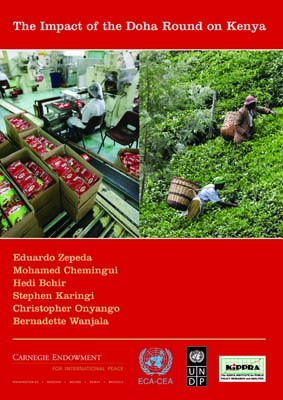Kenya’s economy has yet to recover from the global financial crisis and the political upheaval and social violence that followed the disputed elections at the end of 2007. The implementation of a likely agreement of the ongoing Doha Round of trade negotiations would improve Kenya’s competitive position in processed food and agriculture, but would harm manufacturing and mining. Depending on the content of negotiations, the liberalization of trade in goods would boost the country’s GDP by 0.2 percent annually, placing Kenya on the winning side of Doha. However, the benefits would be small, according to the report from the Carnegie Endowment, United Nations Economic Commission for Africa, United Nations Development Programme, and Kenya Institute for Policy Research and Analysis.
Key Conclusions:
- Eliminating export subsidies for agriculture in Europe and the United States would help Kenya more than partial reductions of domestic support to agriculture in these countries and cuts to tariffs around the world.
- Kenya would enjoy gains in agriculture, processed food, and the service sector, but experience losses in manufacturing and mining.
- Losses in manufacturing and mining follow the weakening of domestic protection in Kenya.
- Changes in the Kenyan economy would decrease poverty, and income distribution in rural regions would fall slightly, but the gap between wages in urban versus rural areas would expand.
- The Doha Round is likely to diminish the importance of Kenya’s regional partners in total trade as its exports of manufactured goods would fall—these goods are often destined for African countries.
- Countries in sub-Saharan Africa should not expect major net gains stemming from the current round of trade negotiations. This underscores the need for human development policies that will accompany trade liberalization.
“The impact of the Doha Round can lead the Kenyan economy to further specialize in agriculture and processed food. And specialization in these activities can help Kenya make good use of its unskilled labor, its most abundant factor,” write the authors. “But Kenya’s long-term development cannot rest on only these two activities. Kenya must aim to build dynamic comparative advantages in activities with higher value added that can support higher standards of living. Trade can help, but trade by itself will not do the job.”
